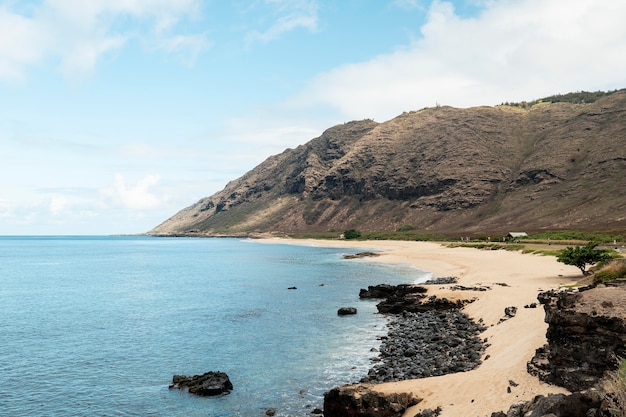
La Gomera offers a unique and untouched atmosphere, distinct from its busier Canary Island neighbors. If you’re seeking a peaceful holiday surrounded by nature, our La Gomera travel guide will help you plan your trip.
La Gomera is a fantastic destination for hiking, with ravines offering lush vegetation and stunning views. Even in winter, the island boasts warm temperatures and sunny days, perfect for outdoor activities.
La Gomera is the second smallest of the Canary Islands, located in the Atlantic Ocean off the coast of Africa. It’s easily accessible via a 30-minute ferry ride from Tenerife. The island covers 370 square kilometers of rugged terrain, with central highlands and protected laurel forests in Garajonay National Park. Steep gorges, known as barrancos, run down to the sea, often featuring cultivated terraces and palm groves.
The main towns and villages are situated on the coast or in protected valleys. The coastline is marked by steep cliffs and small pebble coves, with the exception of the more protected south coast, which has dark sand and pebble beaches.
La Gomera offers numerous hiking trails, many based on ancient routes connecting villages across the island’s steep terrain. These trails are especially attractive in winter when the days are warm and sunny. For more information, check out my article on hiking in La Gomera.
One of the most popular activities in La Gomera is visiting Garajonay National Park, which has two visitor centers and many marked walking trails. The visitor centers provide insights into La Gomera’s culture, including the Silbo whistling language, the “shepherd’s leap,” and traditional pottery.
The island has historical connections with Christopher Columbus, who stopped in San Sebastian in 1492 to stock up on supplies before crossing the Atlantic. The island’s capital has museums and a church where Columbus prayed for a safe journey.
The best beaches are in the south, particularly in Valle Gran Rey. These beaches, made of dark sand and pebbles, are pleasant for swimming and relaxing.
For a day trip from Tenerife, consider booking a La Gomera island tour, which includes the ferry crossing and visits to the main sites.
La Gomera is an ideal winter hiking destination, with marked trails throughout the island. Pick up a map of the hiking trails at any tourist information office. For serious hikers, we recommend the La Gomera Rother walking guide.
The island’s main towns and villages include:
– **San Sebastián de la Gomera**: The island’s capital, with connections to Christopher Columbus, museums, a central square, and a pebble beach.
– **Agulo and Hermigua**: Mountain villages offering excellent hiking opportunities.
– **Vallehermoso**: A small working town in the north, ideal for hiking.
– **Parque National de Garajonay**: Known for its unique laurel forests and numerous walking trails.
– **Valle Gran Rey**: A popular seaside resort with black sand beaches.
– **Playa de Santiago**: A beach resort with a sheltered harbor and luxurious accommodations.
San Sebastian has a pedestrianized center, making it easy to explore. The town is proud of its connections with Columbus, who stopped here in 1492.
Agulo and Hermigua offer picturesque northern valleys and excellent hiking opportunities. Vallehermoso has a working Canarian town atmosphere, with locals emerging in the late afternoon for a stroll and chat.
Valle Gran Rey is a holiday resort with many walks starting close to the town. The resort itself has several attractions, including black sand beaches.
Garajonay National Park, established in 1981, protects unique laurel forests and offers many marked trails. The Laguna Grande Visitor Centre is a popular starting point for exploring the park.
The Juego de Bolas Visitor Centre, located just outside the national park, features a museum, botanical garden, craft shops, and information center. The Casa de la Memoria ethnographic museum offers insights into La Gomera’s cultural heritage.
La Gomera has several local specialties, including palm honey, traditional honey, La Mistela liqueur, sweet biscuits, La Gomeran cheese, and Almagrote dip. Canarian specialties like Gofio and Mojo are also popular.
Accommodation options include the historic Parador de la Gomera in San Sebastián, the luxurious Hotel Jardin Tecina in Playa de Santiago, and the welcoming guest house Casa Rural Los Helechos in Agulo. Vallehermoso offers the contemporary Hotel Rural Triana, and Valle Gran Rey has a range of hotels and self-catering apartments.
Most visitors arrive via Tenerife, with international flights into Tenerife South airport. From there, it’s a 30-minute taxi or bus ride to the port at Los Christianos, where ferries to La Gomera depart. Two ferry lines, Fred Olsen and Naviera Armas, operate regular crossings.
Public transport on La Gomera includes buses and taxis. Car hire is also a popular option, with rental services available in San Sebastian, Valle Gran Rey, and Playa Santiago.
The weather in La Gomera is temperate year-round, with warm days and mild nights. Winter temperatures range from 14 to 20 degrees Celsius, while summer temperatures reach up to 26 degrees Celsius. Rainfall is highest in winter, and the island occasionally experiences the Calima, a mist caused by Sahara dust.
The official language is Spanish, but English and German are also spoken, especially in tourist areas. The currency is the Euro, and both cash and debit cards are widely accepted. Tipping is appreciated but not expected.
For more information, visit the La Gomera Tourism website and the Canary Islands Tourism website. Plan your hiking trip with my 7-day itinerary.